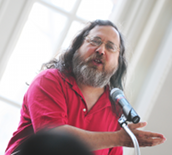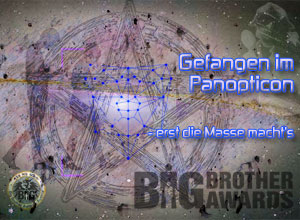

|
search / subscribe / upload / contact |
|
|
||
|
|
||
|
|
||
|
|
||
|
|
||
|
|
||
|
|
||
|
|
||
| RSS-Feed Depeschen | ||

|
||
Date: 1998-08-17
56bit DES crack: Bruce Schneier analysiert-.-. --.- -.-. --.- -.-. --.- -.-. --.- -.-. --.- -.-. --.- updating 98.7.21/2 56bit DES crack: Bruce Schneier analysiert Zum DES/Schlüssel/brechers der Electronic Frontier Foundation fällt dem Ober/Cypherpunk gleich mehrfach Despektierliches ein: Der EFF DEScracker benützt - alte, fade Chiptechnologie - Simples Hardwaredesign - keine besondere Software - kein Cryptographie/Programm - ist also kein Meisterwerk der technik sondern ein ziemlich dummes Geradeaus/Brute/force/Gerät ABER - der DESCracker ist hübsch skalierbar - wobei jede weitere Maschine nur noch ein Viertel der ersten kosten wird. Fazit: Wenn eine Bürgerrechtsorganisation mit veralteter Technologie ein in jeder Hinsicht verbesserungswürdiges Gerät bauen kann, das immerhin den 56bit DES Standard/Schlüssel crackt - dann kann die vom FBI hartnäckig geäusserte Behauptung, die Behörden hätten Schwierigkeiten, 56bit Schlüssel zu entziffern, nur Zeichen von Inkompetenz und/oder einer Lüge sein. ceterum/censeo nicht vergessen: Dass 56bit DES der Online-Banking Standard in Östreeich und Deutschland ist. -.-.- --.- -.-.- --.- -.-.- --.- A Hardware DES Cracker by Bruce Schneier August 15, 1998 On 17 July the Electronic Frontier Foundation (EFF) announced the construction of a DES brute-force hardware cracker. This $220,000 device can break a DES key in an average of 4.5 days. The news here is not that DES is insecure, that hardware algorithm-crackers can be built, or that a 56-bit key length is too short. We've known all of this already; cryptographers have been saying it for years. (My book said it in 1994.) Technological predictions made about the declining costs of such a machine, made in the late 1970s, the 1980s, and the early 1990s, turned out to be dead-on. The news is how long the government has been denying that these machines were possible. As recently as 8 June 98, Robert Litt, principal associate deputy attorney general at the Department of Justice, denied that it was possible for the FBI to crack DES. "[It is a myth that] we have supercomputers that can crack anything that is out there," Litt said. "Let me put the technical problem in context: It took 14,000 Pentium computers working for four months to decrypt a single message.... We are not just talking FBI and NSA [needing massive computing power], we are talking about every police department." (See the full story at http://www.wired.com/news/news/politics/story/12830.html.) My comment was that the FBI is either incompetent or lying, or both. EFF's machine is not cutting-edge engineering. It is not state-of-the-art cryptography. It is not bleeding-edge technology. The machine uses old, boring chip technologies, simple hardware design, not-very-interesting software, and no cryptography. This is not a marvel of engineering; the only interesting thing is how straightforward the design really is. Moreover, the machine scales nicely. EFF spent $220,000 on their first machine. Now that the design work is done, they can build a second for about $50,000. For every doubling of that price, they can double the speed of the machine (so a second machine for $250,000 can break DES in less than a day). And Moore's Law predicts that the same machine will be either twice as fast or twice as cheap in another 18 months. The EFF machine broke DES, but it could just as easily have been designed to break any other encryption algorithm. The attack was against the key length, not against the algorithm design. Moreover, a slightly more expensive design would have used FPGAs, allowing the system to work against a variety of algorithms and algorithm variants. The only solution here is to pick an algorithm with a longer key. DES has a fixed 56-bit key. Triple-DES has a 112-bit key; there isn't enough silicon in the galaxy or enough time before the sun burns out to brute-force triple-DES. AES requires 128-, 192-, and 256-bit keys. The EFF is a civil liberties group, and this was just a demonstration project. Government agencies like the FBI and the NSA would presumably spend a lot more time engineering a more efficient solution. It is reasonable to assume that any country with an intelligence budget has built this sort of machine, probably one a couple of orders of magnitude faster. There are undoubtably many, many technical improvements that can be made to the EFF design to make brute-force search cheaper and faster. But the fact that a civil liberties group can use old technology to build something that the adminstration has denied can be built...that's the real news. relayed by Bruce Schneier http://www.counterpane.com/ related links EFF's press release: http://www.eff.org/descracker/ Wired News: http://www.wired.com/news/news/technology/story/13800.html Cnet: http://www.news.com/News/Item/0%2C4%2C24322%2C00.html?sas.mail New York Times story: http://www.nytimes.com/library/tech/yr/mo/biztech/articles/17encrypt.html. -.-.- --.- -.-.- --.- -.-.- --.- TIP Download free PGP 5.5.3i (Win95/NT & Mac) http://keyserver.ad.or.at/pgp/download/ -.-.- --.- -.-.- --.- -.-.- --.- - -.-. --.- -.-. --.- -.-. --.- -.-. --.- -.-. --.- -.-. --.- edited by published on: 1998-08-17 comments to office@quintessenz.at subscribe Newsletter - -.-. --.- -.-. --.- -.-. --.- -.-. --.- -.-. --.- -.-. --.- |
|
|
|
| CURRENTLY RUNNING | |
q/Talk 1.Juli: The Danger of Software Users Don't Control

|
|
| !WATCH OUT! | |
bits4free 14.Juli 2011: OpenStreetMap Erfinder Steve Coast live in Wien

|
|

